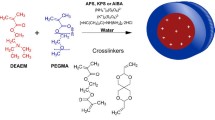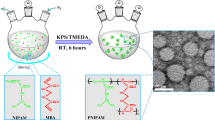Abstract
The objective of this study was to develop new self-organized nanogels as a means of drug delivery in patients with cancer. Pullulan (PUL) and deoxycholic acid (DOCA) were conjugated through an ester linkage between the hydroxyl group in PUL and the carboxyl group in DOCA. Three types of PUL/DOCA conjugates were obtained, differing in the number of DOCA substitutions (DS; 5, 8, or 11) per 100 PUL anhydroglucose units. The physicochemical properties of the resulting nanogels were characterized by dynamic light scattering, transmission electron microscopy, and fluorescence spectroscopy. The mean diameter of DS 11 was the smallest (approx. 100 nm), and the size distribution was unimodal. To determine the organizing behavior of these conjugates, we calculated their critical aggregation concentrations (CACs) in a 0.01-M phosphate buffered saline solution. They were 10.5×10−4 mg/mL, 7.2×10−4 mg/mL, and 5.6×10−4 mg/mL for DS 5, 8, and 11, respectively. This indicates that DOCA can serve as a hydrophobic moiety to create self-organized nanogels. To monitor the drug-releasing behavior of these nanogels, we loaded doxorubicin (DOX) onto the conjugates. The DOX-loading efficiency increased with the degree of DOCA substitution. The release rates of DOX from PUL/DOCA nanogels varied inversely with the DS. We concluded that the PUL/DOCA nanogel has some potential for use as an anticancer drug carrier because of its low CAC and satisfactory drug-loading capacity.
Similar content being viewed by others
References
Yokoyama, M. and T. Okano (1996) Targetable drug carriers present status and a future perspective.Adv. Drug Deliv. Rev. 21: 77–80.
Maeda, H., J. Wu, T. Sawa, Y. Matsumura, and K. Hori (2000) Tumor vascular permeability and the EPR effect in macromolecular therapeutics: a review.J. Control. Release 65: 271–284.
Kong, G., R. D. Braun, and M. W. Dewhirst (2001) Characterization of the effect of hyperthermia on nanoparticle extravasation from tumor vasculature.Cancer Res. 61: 5027–5032.
Hashida, M., H. Hirabayashi, M. Nishikawa, and Y. Takakura (1997) Targeted delivery of drugs and proteins to the liver via receptor-mediated endocytosis.J. Control. Release 46: 129–137.
Leamon, C. P. and P. S. Low (1991) Delivery of macromolecules into living cells; a method that exploits folate receptor endocytosis.Proc. Natl. Acad. Sci. USA 88: 5572–5576.
Park, H. G. (2003) Nanoparticle-based detection technology for DNA analysis.Biotechnol. Bioprocess Eng. 8: 221–226.
Na, K., K. H. Park, S. W. Kim, and Y. H. Bae, (2000) Self-aggregated hydrogel nanoparticles from curdlan derivatives: characterization, anti-cancer drug release, and interaction with a hepatoma cell line (HepG2).J. Control. Release 69: 225–236.
Na, K., T. B. Lee, K. H. Park, E. K. Shin, Y. B. Lee, and H. K. Choi (2005) Self-assembled nanoparticles of hydrophobically-modified polysaccharide bearing vitamin H as a targeted anti-cancer drug delivery system.Eur. J. Pharm. Sci. 18: 165–173.
Na, K. and Y. H. Bae (2002) Self-assembled hydrogel nanoparticles responsive to tumor extracellular pH from hydrophobized pullulan and sulfonamide conjugate: Characterization, aggregation, and adriamycin releasein vitro.Pharm. Res. 19: 681–688.
Na, K., K. H. Lee, and Y. H. Bae (2004) pH-sensitivity and pH-dependent interior structure change of self-assembled hydrogel nanoparticles of pullulan acetate/oligo (methacryloyl sulfadimethoxine) (PA/OSDM) conjugate.J. Control. Release 97: 513–525.
Na, K., E. S. Lee, and Y. H. Bae (2003) Adriamycin loaded pullulan acetate/sulfonamide conjugate nanoparticles responding to tumor pH: pH-dependent cell interaction, internalization, and cytotoxicityin vitro.J. Control. Release 87: 3–13.
Akiyoshi, K., S. Deguchi, H. Tajima, T. Nishikawa, and J. Sunamoto (1997) Microscopic structure and thermoresponsiveness of a hydrogel nanoparticle by self-assembly of a hydrophobized polysaccharide.Macromolecules 30: 857–861.
Nishikawa, T., K. Akiyoshi, and J. Sunamoto (1996) Macromolecular complexation between bovine serum albumin and the self-assembled hydrogel nanoparticle of hydrophobized polysaccharide.J. Am. Chem. Soc. 118: 6110–6115.
Lee, K. Y., W. H. Jo, I. C. Kwon, Y. H. Kim, and S. Y. Jeong (1998) Physicochemical characteristics of self-aggregates of hydrophobically modified chitosans.Langmuir 14: 2329–2332.
Lee, K. Y., W. H. Jo, I. C. Kwon, Y. H. Kim, and S. Y. Jeong (1998) Structural determination and interior polarity of self-aggregates prepared from deoxycholic acid-modified chitosan in water.Macromolecules 31: 378–383.
Lee, Y. K., J. H. Nam, H. C. Shin, and Y. Byun (2001) Conjugation of low-molecular-weight heparin and deoxycholic acid for the development of a new oral anticoagulant agent.Circulation. 104: 3116–3120.
Kratohvil, J. P., W. P. Hsu, and D. I. Kwok (1986) How large are the micelles of di-α-hydroxy bile salts at the critical micellization concentrations in aqueous electrolyt solutions? Results for sodium taurodeoxycholate and sodium deoxycholate.Langmuir 2: 256–258.
Choi, D. B., W. S. Cha, S. H. Kang, and B. R. Lee (2004) Effect of pleurotus ferulae extracts on viability of human lung cancer and cervial cancer cell line.Biotechnol. Bioprocess Eng. 9: 356–361.
Park, S. M., A. Y. Mo, Y. S. Jang, J. H. Lee, M. S. Yang, and D. H. Kim (2004) Expression of a functional human tumor necrosis factor-α (hTNF-α) in yeastsaccharomyces cerevisiae.Biotechnol. Bioprocess Eng. 9: 292–296.
AHFS (1998)Drug Information. 98: 802–810.
Jeong, Y. I., J. B. Cheon, S. H. Kim, J. W. Nah, Y. M. Lee, Y. K. Sung, T. Akaike, and C. S. Cho (1998) Clonazepam release from core-shell type nanoparticlesin vitro.J. Control. Release 51: 169–178.
Gref, R., Y. Minamitake, M. T. Peracchia, V. Trubetskoy, V. Torchilin, and R. Langer (1994) Biodegradable long-circulating polymeric nanospheres.Science 263: 1600–1603.
Chung, J. E., M. Yokoyama, and T. Okano (2000) Inner core segment design for drug delivery control of themoresponsive polymeric micelles.J. Control. Release 65: 95–103.
Author information
Authors and Affiliations
Corresponding author
Rights and permissions
About this article
Cite this article
Na, K., Park, K.M., Jo, E.A. et al. Self-organized pullulan/deoxycholic acid nanogels: Physicochemical characterization and anti-cancer drug-releasing behavior. Biotechnol. Bioprocess Eng. 11, 262–267 (2006). https://doi.org/10.1007/BF02932041
Received:
Accepted:
Issue Date:
DOI: https://doi.org/10.1007/BF02932041




